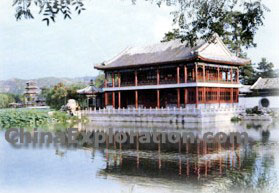search for a Trip
Introduction of Chengde
Located 256 kilometers northeast of Beijing, Chengde is surrounded by the mountains. Its major tourist attractions are the Chengde Mountain Resort and Eight Outer Temples. Built in the 42nd year of the Kang Xi's reign of the Qing (1703), the Chengde Mountain Resort was the former out palace of Emperor Kang Xi and other Qing rulers of the time. The palace structures along with the temple built in the place show the different styles of architecture by various Chinese nationalities. The mountain resort possesses scenery featuring those of both north and south China. For their unique shapes and beauty of color, the Eight Outer Temples represent the different features of the culture of the Han, Tibet, Mongolia and other minority nationalities.
The main attractions in Chengde
The Chengde Mountain Resort
 Situated in the northern part of Chengde, the Mountain Resort, also called the Temporary Imperial Dwelling Palace in Rehe, was built by the Emperors Kangxi and Qianlong of the Qing Dynasty (1644 A.D-1911 A.D) for the sake of stabilizing the frontier region and maintaining the unity of multi - nationalities. This large resort is considered the most remarkable imperial garden still existing today in China. The Chengde Mountain Resort was the former out palace of Emperor Kang Xi and other Qing rulers of the time. The palace structures along with the temple built in the place show the different styles of architecture by various Chinese nationalities. The mountain resort possesses scenery featuring those of both north and south China.
Situated in the northern part of Chengde, the Mountain Resort, also called the Temporary Imperial Dwelling Palace in Rehe, was built by the Emperors Kangxi and Qianlong of the Qing Dynasty (1644 A.D-1911 A.D) for the sake of stabilizing the frontier region and maintaining the unity of multi - nationalities. This large resort is considered the most remarkable imperial garden still existing today in China. The Chengde Mountain Resort was the former out palace of Emperor Kang Xi and other Qing rulers of the time. The palace structures along with the temple built in the place show the different styles of architecture by various Chinese nationalities. The mountain resort possesses scenery featuring those of both north and south China.
Mulan Hunting Site:
Mulan Hunting Site (Mulan Weichang) is famous for its natural hunting. It used to be royal hunting site in the Qing Dynasty (1644-1901 A.D.) and now it is a nice place for cooling off in summer and skiing and hunting in winter. It is located in Weichang County, Chengde city, with an area of 2324 square kilometers in which Saihanba Spot counts 1685 square kilometers and the Saihanba National Forest Park is in the spot. Since ancient time it has been a fertile place, a natural imperial garden. "Pine Trees for One-thousand-li" has ever been the hunting place for the Emperor in Liao Dynasty. "Mulan Weichang" is also the place for Emperor in the Qing Dynasty to hold the Mulan hunting in autumn. Nowadays, it still keeps the feature of nature and simplicity, keeps the primitive beauty.
Pule Temple:
Located in the north-west of Chengde city, the Pule Temple was built in 1766 A.D, by Qianlong Emperor. After the rebellions in Xinjiang area was suppressed by central government of the Qing Dynasty, more and more ethnic minorities groups leaders came to Chengde Mountain Resort to present themselves to the Emperors and spend their summer holidays together. The temple was constructed to show the respect of central government to the Minorities. It consists two parts: the front parts are traditional Chinese architectures while the back parts are Tibetan Buddhism style buildings as well as Buddhist rites.
The Eight Outer Temples:
Outside the Chengde Mountain Resort, there are twelve temples built during the Qing Dynasty (1644 A.D~1911 A.D). Dominated by eight districts at that time, they were called the Eight Outer Temples. It took 67 years to build these temples. Standing for the different architectural style of various Minorities in China, the Eight Outer Temples is the symbol of the country unity and minorities solidification. As they were under eight different administrations, they were usually referred to as the eight Outer Temples. Eleven splendid temples were built more than two hundred years ago east and north of the resort. Only seven temples remain intact today, reflecting the traditional art and culture of the Han, Manchu, Mongolian, and Tibetan nationalities.
Climate of Chengde
|
Month |
Jan |
Feb |
Mar |
Apr |
May |
Jun |
Jul |
Aug |
Sep |
Oct |
Nov |
Dec |
|
Temperature (Celsius) |
-6.6 |
-4.2 |
2.5 |
11.1 |
17.0 |
24.0 |
29.8 |
30.4 |
18.1 |
11.1 |
4.1 |
-2.7 |
China Attractions Guide
- Anhui Attractions
- Beijing Attractions
- Chongqing Attractions
- Fujian Attractions
- Gansu Attractions
- Guangdong Attractions
- Guangxi Attractions
- Guizhou Attractions
- Hainan Attractions
- Henan Attractions
- Hongkong Attractions
- Hubei Attractions
- Hunan Attractions
- Inner Mongolia Attractions
- Jiangsu Attractions
- Jiangxi Attractions
- Manchuria Attractions
- Ningxia Attractions
- Qinghai Attractions
- Shaanxi Attractions


